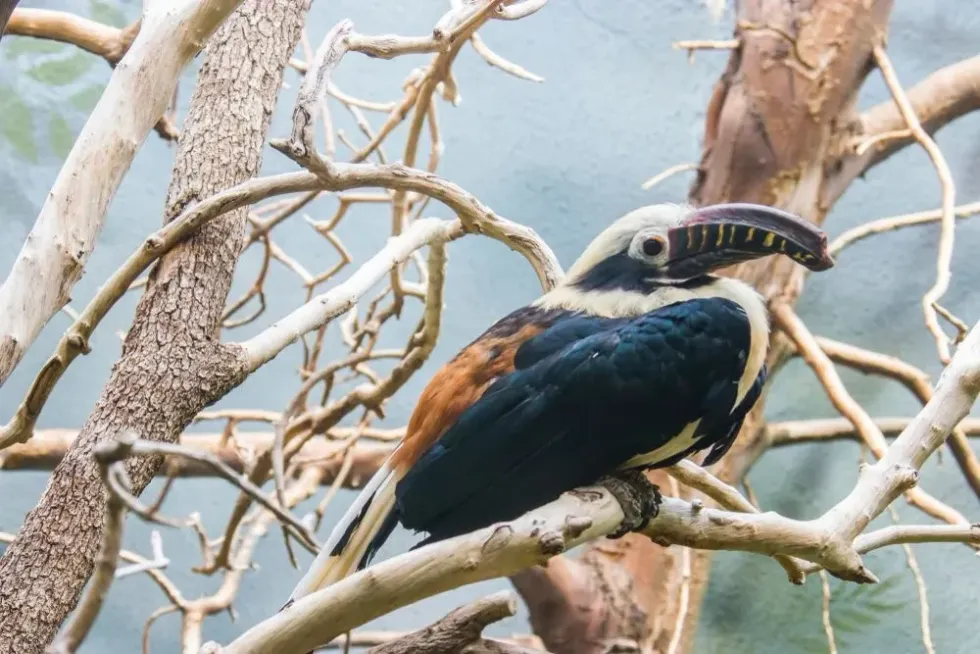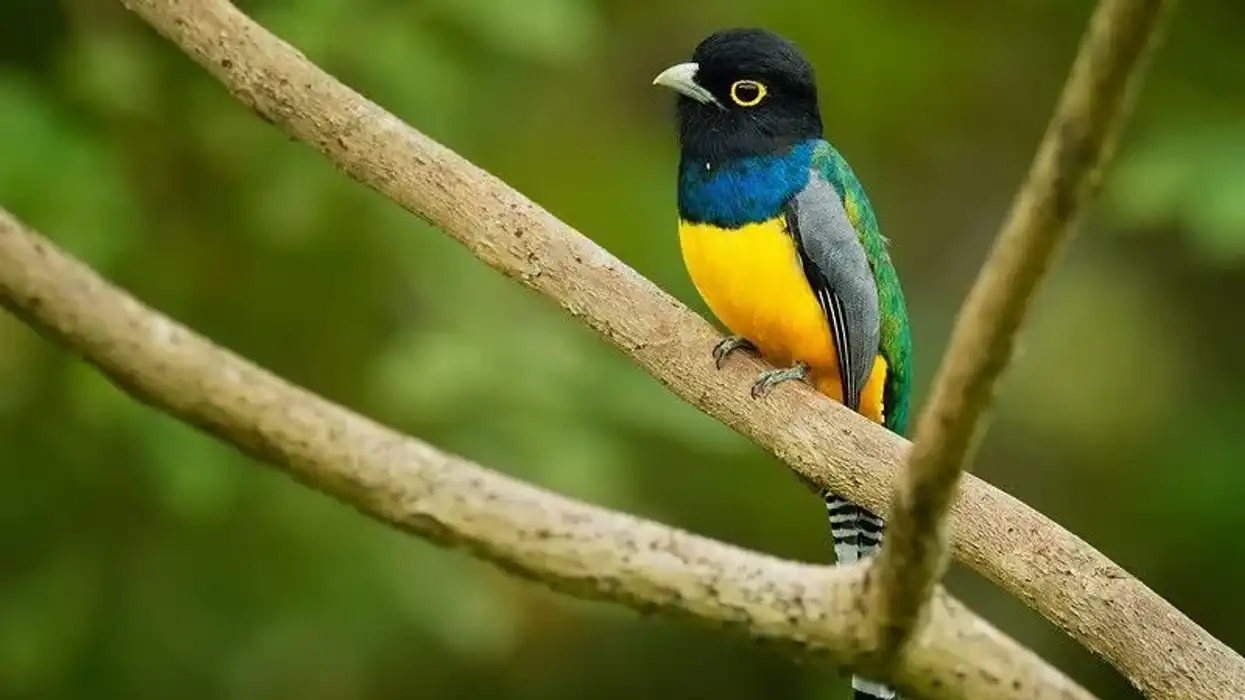The Visayan Hornbill belongs to the family of Bucerotidae from the genus Penelopides. They are beautiful birds found in the rainforests on the island of Panay, negros, Masbata, and Guimaras.
A small population of this bird is also found on the island of Ticao in the Philippines. It can be said that they are endemic birds. They are exclusively found in the areas just mentioned.
This species of hornbill bird has been recognized by the Internation Union of Conservation of Nature as an Endangered animal. There is a chance they might go extinct soon since their population is around the range of 1800.
These birds are monogamous and flock in small, tight-knit groups. They are sometimes found on canopies with their flock. Their breeding season begins in the month of April.
Their diet consists of a combination of fruits and ants, worms, and beetles. These birds exhibit very calm and peaceful behavior.
To know more about this bird, keep reading this page. Information regarding their weight, length, sounds, subspecies, conservation status can be found amongst other things. Also, check our articles on the wreathed hornbill and black hornbill for more fascinating facts about wild animals and birds.
Visayan Hornbill Interesting Facts
What type of animal is a Visayan hornbill?
A tarictic hornbill (Penelopides panini) is a species of hornbill from the Bucerotidae family of the Penelopides genus. Their common name is Visayan hornbill. They are also referred to as tarictic hornbills. They are an endangered species of birds that are found on the islands of Panay, Ticao, Masbate, Negros, and Guimaras.
What class of animal does a Visayan hornbill belong to?
The Visayan Hornbill (Penelopides Panini) belongs to the class of Aves of the Animalia kingdom.
How many Visayan hornbills are there in the world?
The Visayan (tarictic) hornbill is a bird species that are endangered and there is a high risk that they will become extinct soon. There are only 1800 hornbills of this species in the world. They are a highly endangered species of hornbill.
Where does a Visayan hornbill live?
The tarictic hornbill (Penelopides panini) is a bird species that prefers to reside in rainforests on the islands of the Philippines, Guimaras, Panay, Negros, and Masbate. This species of hornbills have been imported to a zoo in England from the Philippines where they are being bred.
There are also two pairs of hornbills of this species in Chester and the Netherlands.
What is a Visayan hornbill's habitat?
The habitat of a Visayan (tarictic) hornbill (Penelopides panini) is rainforests. They live on the islands of Panay, Negros, Masbate and Guimaras. This bird species used to previously be found at the Ticao island in the Philippines.
Who do Visayan hornbills live with?
The tarictic hornbill (Penelopides panini) lives in small to medium-sized flocks. These flocks consist of juvenile hornbills and breeding pairs. However, they congregate in large numbers after sunset on canopies as well.
How long does a Visayan hornbill live?
The lifespan of a Visayan hornbill (Penelopides panini) is not known to us. We do know that their native habitat, which is the rainforest, has been converted by humans into mango plantations due to which their population has decreased.
They have become an endangered species due to human interference in their natural habitat. There are efforts taken by various organizations for the conservation of their population.
How do they reproduce?
The information regarding their breeding process has gone largely undocumented. The breeding season of Visayan hornbill (Penelopides panini) of the family Bucerotidae is around the month of April. The clutch of tarictic hornbills is two or three. Their incubation period is unknown to us.
It is probably 30-35 days. The nestling period of a Visayan hornbill (Penelopides panini) is around 55-58 days. Juvenile tarictic hornbills resemble the plumage of their respective sex.
What is their conservation status?
Tarictic hornbills are an endangered species of the subspecies of hornbills. There are around 1800 Visayan (tarictic) hornbills in this world.
The island on which they originally resided was converted into a mango plantation by human beings which has led to this situation now. They lived on the Ticao island in the Philippines. There are efforts taken up by various organizations around the world to contribute to the conservation of the Visayan tarictic hornbill.
Visayan Hornbill Fun Facts
What do Visayan hornbills look like?
The Visayan tarictic hornbill is a species of bird that exhibit sexual dimorphism. This means that sexes of the same species have different characteristics which are not necessarily related to the process of reproduction. The male Visayan tarictic hornbill (Penelopides panini) has a creamy white head and neck.
Their neck is of the same color. They also have a creamy whitetail and a reddish-brown lower chest.
Male and female birds have the same bill and tail. Their bill is a shade of black with yellow ridges. Female birds have a black plumage unlike the male hornbill of this species.
How cute are they?
The Visayan tarictic hornbill (Penelopides panini) is very beautiful and looks magnificent with its bright body color and bill.
How do they communicate?
Their particularities of the method of their communication are not known to us. They emit a noisy sound that resembles their namesake 'ta-rik-tik.' We can say that similar to other birds they also communicate through various sounds and body posture.
How big is a Visayan hornbill?
These birds weigh 15 oz (435 g) and are 17.7 in (45 cm) in length. That makes them about the same size as a house cat.
How fast can a Visayan hornbill fly?
The exact speed at which birds of these species can fly is not known to us.
How much does a Visayan hornbill weigh?
A Visayan hornbill weighs around 15 oz (435 g).
What are the male and female names of the species?
Like other birds, a male hornbill is called a cock and a female hornbill is referred to as a hen. They are a species of bird that exhibit sexual dimorphism.
What would you call a baby Visayan hornbill?
A baby Visayan hornbill is referred to as a chick.
What do they eat?
These birds take a combined diet of fruits found in the forests they live in, as well as beetles, earthworms, and ants.
Are they dangerous?
Birds of this species are usually not dangerous. They are a species of endangered bird so they are more susceptible to danger from human interference. When they are in a situation where they sense a threat, these birds prefer to not engage and simply step back.
Would they make a good pet?
Birds of this species are very peaceful and calm behavior-wise. They are large in size and might not be able to adapt to environments that are unlike their habitat.
We should keep in mind that they live in rainforests on the island of Ticao in the Philippines, Negros, Panay, and Guimaras. So it is not possible for them to live in urban or suburban areas confined within small homes.
Did you know...
The hornbill bird was first described by the French polymath Georges-Louis Leclerc and Comte de Buffon. François-Nicolas Martinet created a painting of this species of bird which accompanied the text of Leclerc and Comte.
The common name of this bird refers to the Visayan islands located in the central part of the Philippines. However, the text or illustration of these men did not mention the scientific name of this bird.
It was only in 1849 that the bird was named such by the naturalist Ludwig Reichenbach.
The areas mentioned also include the island of Panay. This will make so much sense when you come to know that the specific epithet of 'panini' from their scientific name has been borrowed from the name of the island of Panay.
Two subspecies of this bird have been recognized. One of them is the ticaensis and the other is panini.
How many eggs do the Visayan hornbills lay?
The bird of this species lays two to three eggs at once.
Is the Visayan hornbill endemic?
The birds of this species are endemic and are found exclusively in the rainforests on the island of Ticao in the Philippines, Negros, Panay, and Guimaras. Although, they have been imported from the island of Ticao, Philippines to the Chester Zoo in England. The hornbill bird still lives on the island of Panay, Negros, Masbate and Guimaras.
Here at Kidadl, we have carefully created lots of interesting family-friendly animal facts for everyone to discover! Learn more about some other birds from our Malabar gray hornbill fun facts and flycatcher interesting facts for kids pages.
You can even occupy yourself at home by coloring in one of our free printable hornbill bird coloring pages.










